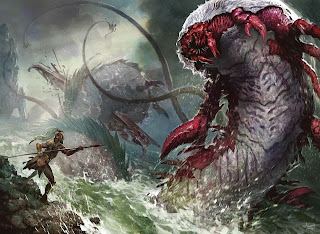Labor Day is a good time to take a look back at a post I did back in 2013 on the Labors of Hercules (the link there will refresh you on the background) through a science fantasy lens in the Gods, Demi-gods & Strangeness setting I did some blogging about back then.
1: In the first labor, Hercules killed the Nemean lion. Given the Olympians penchant for genetically reviving extinct species, this was probably a cave lion of some sort. Perhaps a specimen of Panthera leo fossilis as big as Panthera leo atrox, the America cave lion: something like 8 ft. long and 4 ft. tall at the shoulder. The being invulnerable thing is probably just fanciful exaggeration--or is it?
3: Hercules only captured the Golden Hind of Artemis (the Cerynitian Hind). This was one of a group of specialized genetically engineered deer of genus Eucladoceros kept by Artemis. They were engineered so (like modern reindeer) the females had antlers.
4: Next Hercules captured the Erymanthian Boar. I've written about these "giant boar" previously.
5: The stables of Augeas were really, really disgusting. Why were his livestock immortal?
6: After that, Hercules slayed a group of Stymphalian birds--which of course aren't birds at all.
7: Hercules captured the rampaging Cretan Bull. As previously established, this creature wasn't the father of the Minotaur. Instead, it was a large auroch as enraged and violent as that big buffalo in White Buffalo (1977).
8: Capturing the Mares of Diomedes was difficult because they were carnivorous. They must have been some mad creation of Olympian science.
9: Next Hercules stole the belt of the Queen of the Amazons, Hippolyta. This belt was a gift of Ares and a symbol of her authority, but didn't have any particular powers. Probably.
10: For his next labor, Hercules does a little cattle-rustling. He goes to an island of Erytheia far the the West (probably modern Spain) and steals special cattle (likely bioengineered to produce something for the Olympians--perhaps a component of nectar or ambrosia?) from Geryon. Geryon is said to have three bodies, which probably means his consciousness runs in three duplicates. He also had a 2 headed dog.
11:Returning to the far west and still messing with Olympian pharma, Hercules stole the Golden Apples of the Hesperides. He had to kill a dragon (or a guardian of some sort) and dealt with Atlas, who was the artificial intelligence of an installation that protected against threats from space.
12: Finally, he captured Cerberus. This guardian of Hades is a nanite swarm often taking the vague form of a large three headed dog.
Have a good Labor Day!





.jpg)























-1.jpg)




